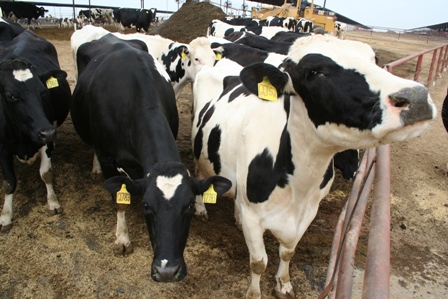No anomalies found at dairies or in feed records.
 Two central California dairies connected to the discovery of Bovine Spongiform Encephalopathy (BSE) in a cow in April were released from quarantine this week, federal officials said May 18.
Two central California dairies connected to the discovery of Bovine Spongiform Encephalopathy (BSE) in a cow in April were released from quarantine this week, federal officials said May 18.
The quarantines were placed on the two dairies earlier this month after USDA's Animal and Plant Health Inspection Service (APHIS) announced April 24 it had confirmed the nation’s fourth case of BSE in an animal that was sampled for the disease at a rendering facility in central California.
In addition to the Tulare County dairy where the cow had lived, a hold order had been placed on all cattle at a second dairy ("dairy 2") associated with the Tulare County dairy of the initial positive cow (also called the "index dairy"), USDA-APHIS said.
USDA says the stricken animal was never presented for slaughter for human consumption, so it never posed a risk to the food supply or to human health in the U.S.
After USDA's National Veterinary Services Laboratories (NVSL) completed testing of the samples from the index animal, the samples were sent to The World Organization for Animal Health (OIE) reference laboratories in Canada and England. Both laboratories have confirmed that the index cow was positive for atypical (L-type) BSE.
Both dairies that were previously held under quarantine during the investigation have been released from those quarantines, after inventories were completed and records were reviewed.
In addition, investigation of the feed records at the index dairy premises has found no anomalies, and audits of all the feed suppliers to the index premises have shown them to be in compliance with the regulations.
APHIS previously announced that it had identified two progeny of the positive cow. One progeny born to the positive cow in the last 2 years was stillborn; the second animal was appraised, humanely euthanized, and sampled for BSE at the National Veterinary Services Laboratories in Ames, Iowa. Test results for that animal were negative for BSE.
Of several hundred potential birth cohort cattle, the focus of the tracing is on a small number (10-12) of cattle which may still be alive and have records that might allow them to be located. The remaining potential cohorts are no longer alive or have otherwise been ruled out.
As the investigation moves toward completion, local officials from the California Department of Food and Agriculture and USDA-APHIS Veterinary Services are now in charge of the incident command.
The U.S. has a longstanding system of three interlocking safeguards against BSE that protects public and animal health in the nation.
The most important is the removal of specified risk materials -- or the parts of an animal that would contain BSE should an animal have the disease -- from all animals presented for slaughter. The second safeguard is a strong feed ban that protects cattle from the disease. The third safeguard , which led to this detection, is USDA’s ongoing BSE surveillance program, which allows the agency to detect the disease if it exists at very low levels in the U.S. cattle population.









